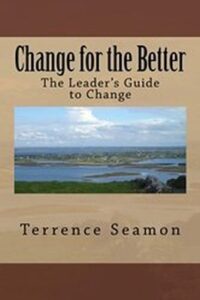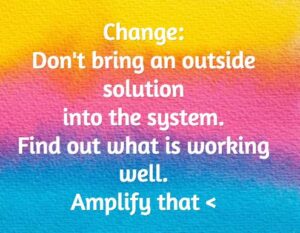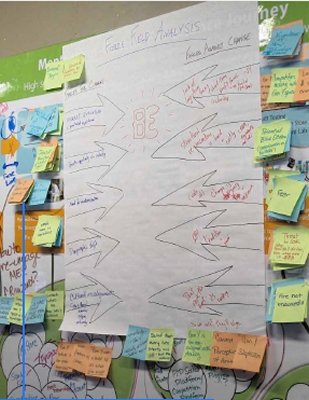Terrence Seamon is a seasoned Organization Development consultant, based in New Jersey, USA. He is passionate about change and loves to write. After he published his book Change for the Better, I interviewed him about change. Join us as we discuss positive deviance, resistance, Theory Y and Kurt Lewin’s Force Field Analysis.
Marcella Bremer: You just published your third book: Change for the Better. Why?
Terrence Seamon: My books represent my work over the last 30 years in managing change, leadership development, and corporate culture. I am passionate about this.
My first book “To Your Success” is for people in a career transition. You either choose this kind of change or it is thrust upon you. The second book is “Lead the Way” for anyone in a leadership role who wants to be a more engaging leader. Employee engagement and leadership have a big overlap: you have to be engaging as a leader, and you have to involve your people on a daily basis.
My third book, “Change for the Better” is about change: it’s for anyone who is in a change agent role – and that goes beyond formal organizations! Parents may want to initiate positive change in their family, like: the kids take more responsibility for chores in the house. That can be a tough change issue. If you know how to do this, you can change IBM, in an way 😉

I believe anyone can be a change agent. Teachers, parents, neighbors, but also Organization Development consultants and managers. I didn’t write this as an Organization Development book only. I tried to make it personal, hopeful, practical – away from jargon – to inspire anyone. I want to help people go through change. I explain some practical principles. They are things I have learned along the way: pitfalls but also how to be excellent.
Marcella Bremer: What are some useful principles for change?
Terrence Seamon: My principles are partly inspired by an OD consultant called Herb Shepard. But I also speak from experience. One of my principles is: When planning to change things – find out what is already working well. This one I learned when I was working for a corporation, back in the eighties, and I was sent to training and expected to get back with a model to apply. This one principle was so powerful. I think it was even before Appreciative Inquiry got well known. It made so much sense: be careful first to assess what you want to keep and build the change from there. Don’t throw the baby out with the bath water!
I learned positive deviance from a couple on stage, at some conference, who were doing development work in Africa. It struck me. They would go into communities and found out that someone already had broken the code – someone knows how to solve a problem that a community has. Find that person, study them and help the solution spread into the system. Help the others to deviate positively, too. So: don’t bring an outside solution into the system. That might not be adopted and may create resistance.
 I have also learned to honor resistance; to respect and recognize that it’s coming from a place that should be understood. If you look inside, you can see what it holds. People have feelings, and they are probably hurt. I learned this from Judith Bardwick. She says: Feelings are facts. Find out what’s going on. What is causing the negative feelings about the change project?
I have also learned to honor resistance; to respect and recognize that it’s coming from a place that should be understood. If you look inside, you can see what it holds. People have feelings, and they are probably hurt. I learned this from Judith Bardwick. She says: Feelings are facts. Find out what’s going on. What is causing the negative feelings about the change project?
Marcella Bremer: I still meet many managers who treat feelings as personal stuff and would like to send you to your therapist – they think it’s not appropriate at work.
Terrence Seamon: Yes, this attitude is still here. Command and control: I need your pair of hands, you need to do the work as I say, and that’s it! But we bring our feelings to work. It is the 21st century. We should upgrade. We should move this paradigm and educate the managers we work with as consultants.
Work with a Theory Y approach – people are intrinsically motivated – instead of a theory X approach (when you believe they need control). Theory U is also a new way of thinking; it suits our 21st century to be present in the moment and take systemic complexity into consideration. When you treat people with respect, you will be able to engage them. Managers should be energizers. Instead of de-energizers who demotivate their team.
Marcella Bremer: Do you have a favorite tool?
Terrence Seamon: I love Kurt Lewin’s Force Field Analysis. You get a flip chart or a piece of paper. Draw a vertical line. Think of a particular goal you’re trying to achieve. And then, identify the positive forces. The negative are restraining forces that hold you back. It’s insightful to brainstorm ways to destabilize both sides. Because you need to break up the current balance that keeps everything the way it is! You want the positive factors to be amplified or boosted while the negative factors need to be disturbed or diminished.

I use this a lot with teams but also with individuals in coaching. It helps because it is so visible – you get this overview of where you are and you get ideas of what you need to move, right away. It converts very nicely into an action plan.
People can do this exercise right away. If there’s something you want to change, whether it’s a personal or an organizational or community goal, grab a piece of paper or a paper napkin and do this exercise!
Marcella Bremer: What part of change do you find difficult yourself?
Terence Seamon: Change involves energy and motivation. Nothing will change until I decide to get out of my chair and do something differently. The inertia can be difficult. You can have a great force field analysis hanging on the wall, but you have to move – out of your comfort zone!
Nothing will happen unless you DO something. Even if you start with baby steps – and those small steps are probably the way to go – you’ll create momentum. And then, you don’t want to stop the change anymore – because it’s fun and an adventure. Once you get going, it fuels itself. But to get there… The comfort zone is recognizable for me. Everyone has different inner barriers to get out of their comfort zone. It could be procrastination, perfectionism or the tendency to over-analyze. Whatever it is, we have to overcome it and change.
- What would you like to change? Grab a piece of paper and do a Force Field Analysis.
- What is your favorite tool to help people and organizations change? Please add it in the comments!
Terrence H. Seamon is an organization development consultant who coaches leaders and teams. His latest book, Change for the Better, provides a guide to navigating through organizational change. Terry writes a blog called Here We Are. Now What?
Marcella Bremer is an author and culture & change consultant. She co-founded this blog and ocai-online.com.

This Post Has One Comment
I am taking away from this article some great advice, namely:
– don’t do away with what is working well, build on it
– don’t implement an off the shelf solution or one-size-fit all system
– don’t bury the past, accept it
– nothing will change if you continue to do things the same way
Thank you Marcella for sharing amazing insight from Terrence Seamon.